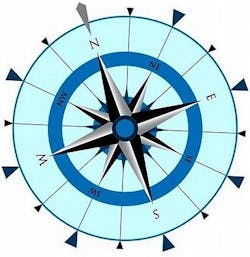Northrop Grumman contract aims at improving GPS-challenged navigation and geo-registration
WOODLAND HILLS, Calif., 25 June 2013. Engineers from the Northrop Grumman Corp. Advanced Navigation Systems business unit in Woodland Hills, Calif., will continue improving geo-registration accuracy for positioning and pointing applications -- even in GPS-denied conditions -- under terms of a navigation research contract announced Monday from the U.S. Air Force Research Laboratory.
Geo-registration of data is critical for accurate interaction between systems, such as locating targets and handing off coordinates to another aircraft, Northrop Grumman officials say.
The contract is for the second phase of an inertial navigation system-related program called Maintain Accurate Geo-registration via Image-nav Compensation (MAGIC). In the first phase of the MAGIC program, Northrop Grumman integrated geo-registration algorithms in a vision-aided inertial navigation system that can operate with use of Global Positioning System (GPS) satellites.
Geo-registration of images involves pairing unreferenced images with the physical locations or exact coordinates of depicted items. This enables aircraft to create accurate maps by stitching together photos and correlating them with their world-based locations, which is useful for intelligence gathering and targeting, company officials say.
Having demonstrated a prototype system in phase one, Northrop Grumman will flight-test the integrated system in phase two as well as incorporate additional improvements such as detailed 3-D map generation in the algorithm.
"Our positioning and geo-registration solution will help to precisely locate our own aircraft positions and target locations, particularly in challenging, high-threat environments where the adversary might be jamming GPS," says Charles Volk, vice president of Northrop Grumman's Advanced Navigation Systems business unit. "Additionally, this will increase the situational awareness of warfighters and help to keep them safer."
Partnered with Toyon Research Corp. in Goleta, Calif., Northrop Grumman capitalizing on the company's vision-aided inertial navigation experience from past programs such as Collaborative Robust Integrated Sensor Positioning, which matched image has and processed visual motion estimations for precise navigation without relying on GPS, company officials say.
The MAGIC program seeks to develop and demonstrate advanced real-time geo-registration and navigation algorithms using a combination of cameras, an inertial measurement unit and GPS information (when available).
The program aims to capitalize on advances in the availability of low-size, -weight, -power and -cost camera systems that make the inclusion of camera information in navigation and geo-registration systems for airborne vehicles a significant opportunity.
For more information contact Northrop Grumman Advanced Navigation Systems online at www.northropgrumman.com.

